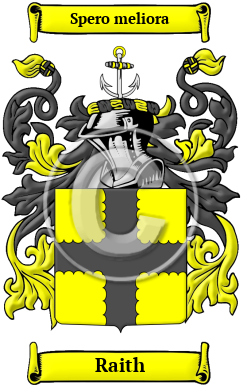| ![Show Contents]() Raith History, Family Crest & Coats of Arms Raith History, Family Crest & Coats of Arms
- Origins Available:
Scotland
Early Origins of the Raith familyThe surname Raith was first found in Nairnshire, where they were recorded as a family of great antiquity. They took their name from the Castle of Rait near Geddes which was in ruins by the 1400s. 1 Today Rait is a small village in Perth and Kinross. The Wraith variant is a Scottish Gaelic word for "ghost" or "spirit." "The name is of considerable antiquity in Scotland. Among the documents preserved in the Exchequer Office is the Submission and Fealty of Sir Gervays de Rate, given at Elgin, July 27th, 1295. Their principal seat was at Hall Green, in the shire of Kincardine, where the older parts of the castle still show their armorial bearings. The first Rait, according to Nisbett, took refuge in the Mearns during the 14th century, having had to leave his native district of Nairnshire for some capital crime. It is certain that Raits were settled in the Mearns, and held the lands of Owres or Uras at that period; but it was not until the close of the following century that they had any connection with Hall Green. From that time, till the year 1724, they were possessed of it; and from them all the Raits of any note in Angus and the Mearns, whether landholders, ministers, farmers, or merchants, claim to be descended." 2 Early History of the Raith familyThis web page shows only a small excerpt of our Raith research. Another 161 words (12 lines of text) covering the years 1280, 1292, 1296, 1297, 1342, 1350, 1355, 1378, 1400, 1478, 1724 and 1990 are included under the topic Early Raith History in all our PDF Extended History products and printed products wherever possible. Raith Spelling VariationsSpelling variations of this family name include: Rait, Raitt, Raid, Rate, Raith and others. Early Notables of the Raith familyNotable amongst the Clan at this time was - John de Rait [Raith, Rathe, Rate, Rathet] was a 14th-century Scottish cleric. He was Archdeacon of Aberdeen (1342-1350) and then Bishop of Aberdeen (1350-1355.)
| Raith migration to the United States | + |
Some of the first settlers of this family name were: Raith Settlers in United States in the 18th Century- Jacob Raith, who landed in Philadelphia, Pennsylvania in 1791 3
Raith Settlers in United States in the 19th Century- Julius Raith, who arrived in St Clair County, Illinois in 1842 3
- Charles Raith, who arrived in St Clair County, III in 1843 3
- Christian Raith, aged 9, who landed in New York in 1854 3
- Dorothea Raith, aged 11, who arrived in New York in 1854 3
- Friedrich Raith, aged 15, who landed in New York in 1854 3
- ... (More are available in all our PDF Extended History products and printed products wherever possible.)
The motto was originally a war cry or slogan. Mottoes first began to be shown with arms in the 14th and 15th centuries, but were not in general use until the 17th century. Thus the oldest coats of arms generally do not include a motto. Mottoes seldom form part of the grant of arms: Under most heraldic authorities, a motto is an optional component of the coat of arms, and can be added to or changed at will; many families have chosen not to display a motto.
Motto: Spero meliora
Motto Translation: I hope for better things.
- Black, George F., The Surnames of Scotland Their Origin, Meaning and History. New York: New York Public Library, 1946. Print. (ISBN 0-87104-172-3)
- Cleveland, Dutchess of The Battle Abbey Roll with some Account of the Norman Lineages. London: John Murray, Abermarle Street, 1889. Print. Volume 3 of 3
- Filby, P. William, Meyer, Mary K., Passenger and immigration lists index : a guide to published arrival records of about 500,000 passengers who came to the United States and Canada in the seventeenth, eighteenth, and nineteenth centuries. 1982-1985 Cumulated Supplements in Four Volumes Detroit, Mich. : Gale Research Co., 1985, Print (ISBN 0-8103-1795-8)
 |

